Pyrolysis heating boilers: principle of operation and types of boilers for long burning
Years go by, science and technology move forward, and solid fuels are still in demand. Burning wood in a traditional stove or in a potbelly stove is not very effective, but the situation was changed by pyrolysis heating boilers - the units are characterized by high efficiency and relatively simple operation.
Agree, these are quite significant arguments when arranging autonomous heating. If you are looking for an effective boiler for the home, then you should take a closer look at the pyrolysis boilers.
We will tell you how long burning units are arranged and work, what are their technical and operational features, and also provide an overview of the most rated models of domestic and foreign manufacturers.
The content of the article:
What is pyrolysis
Firewood is perhaps the very first fuel in human history. Almost everyone knows how quickly they burn out in the open air, and that not so much heat is released. But the situation cardinally changes if you create different conditions for the combustion process.
The so-called pyrolysis combustion is carried out in closed chambers. Firewood or other solid fuels of a similar type are loaded there: pellets, sawdust, wood waste, etc.
The fuel is ignited and then the amount of air entering the chamber is reduced.
As you know, oxidation processes occur during combustion, one of the main participants of which is oxygen contained in the air. If there is little oxygen, the reaction slows down and the wood burns slowly, in fact under such conditions they simply smolder. In this case, a certain amount of thermal energy, ash and combustible gas is released.
The pyrolysis process does not end there. The gas obtained by burning primary fuel is mixed with air masses and also burns. As a result, it emits much more thermal energy than when using standard heat generators.
Therefore, pyrolysis boilers demonstrate a very decent efficiency compared to their purely solid fuel "brothers", as well as often provide the opportunity to significantly save on heating.
The advantage of heating equipment of this type is that the principle of its operation and device is relatively uncomplicated. The amount of air entering the combustion chamber is regulated by a conventional mechanical damper. A simple design ensures the reliability of the device, breakdowns for pyrolysis boilers - this is not a frequent phenomenon.

Another plus of pyrolysis boilers is a long burning period. Full loading of the device with fuel allows you not to interfere with the process for several hours, sometimes more than a day, i.e. there is no need to constantly toss firewood into the furnace, as happens with open burning.
Of course, this does not mean that the pyrolysis boiler can be left unattended. As with other heating equipment, there are strict safety regulations.
It is worth remembering that the pyrolysis boiler is not omnivorous - the humidity of the fuel should be low. Otherwise, part of the precious thermal energy will not be spent on heating the coolant, but on drying the fuel.
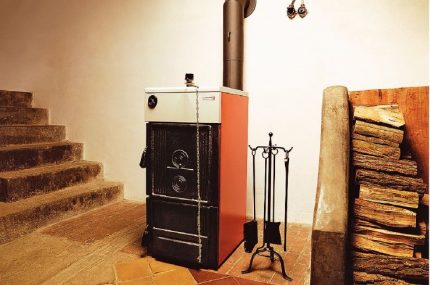
When pyrolysis combustion is realized, the fuel burns out almost completely, it will be necessary to clean the device much less often than when using a traditional solid fuel boiler. Fine ash obtained after cleaning is used as fertilizer. Fuel combustion in such boilers is carried out from top to bottom.
Therefore, the possibilities for natural air circulation in the furnace are noticeably limited. The use of forced air injection with the help of a fan significantly improves the efficiency of the device, but at the same time makes the boiler volatile, because the fan needs electric power.
The device and operation of the pyrolysis boiler
The furnace of the pyrolysis boiler is divided into two compartments. In the first, firewood is burned, and in the second, a mixture of pyrolysis gases and air is secondary burned. Separates the first chamber from the second grate, on which the fuel is laid.
Air is usually forced by a small fan. Although in small models, sometimes a smoke exhauster is used to create traction.
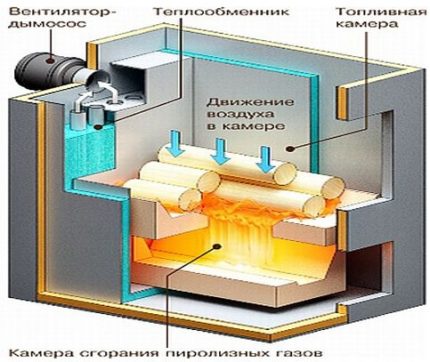
The presence of forced ventilation can be considered the main difference between the pyrolysis boiler and the classical solid fuel model. The housing of the device consists of two parts inserted into each other. The space between the walls is filled with a coolant, the role of which is traditionally played by water.
First, fuel is loaded into the first compartment of the furnace of the pyrolysis boiler, then the fan is turned on and the fuel is ignited. The resulting combustible gases are transferred to the second compartment, mixed with air and burned.
The combustion temperature can reach 1200 ° C. The water in the outdoor heat exchanger is heated and circulated through the home heating system. Residues of combustion products are removed through the chimney.
A relatively high price can be reproached for devices that use the pyrolysis principle of combustion. A conventional solid fuel boiler costs significantly less. But in long-burning boilers, firewood burns out almost completely, which can not be said about the classic boiler.
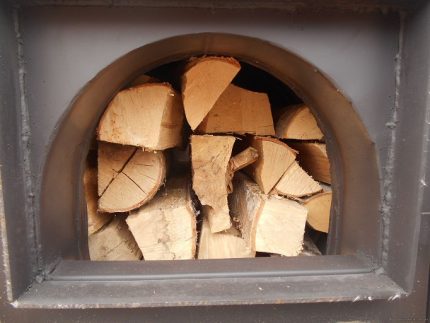
When choosing a pyrolysis boiler, it should be remembered that inexpensive low-power models are usually designed only for firewood. Expensive modifications are able to work on different types of fuel.
Moreover, it will be necessary to load fuel into the device to the maximum, reducing the load leads to increased formation of ash and soot, and also negatively affects the operation of the unit as a whole.
Top burning boilers
One of the options for a pyrolysis device is a top burning boiler. The principle of operation of these two units is very similar.
In the same way, a large amount of solid fuel of low humidity is loaded into the furnace, the air is forcedly forced and the fuel smolders with a reduced amount of oxygen. A valve that controls the flow of oxygen is set in position.

But long-burning boilers have neither an ash pan nor a grate. The bottom is a blank metal plate. Such boilers are designed so that the wood burns out completely, and the small amount of ash remaining in the furnace is blown out by air.
Such devices are characterized by high efficiency and also operate at temperatures above 1000 ° C.
The main feature of such devices is that they really provide a long life at full load. The fuel chamber in such devices is usually in the form of a cylinder.
Fuel is loaded into it from above, from above, in the center, the air necessary for combustion is pumped.
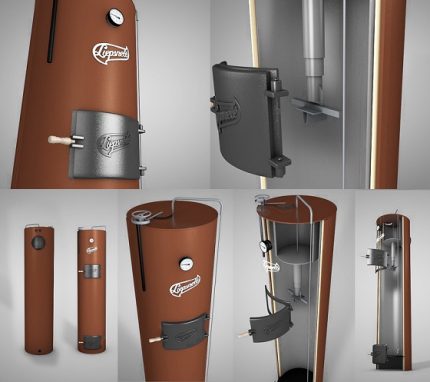
Thus, a slow smoldering of the upper layer of fuel. Fuel gradually burns out, its level in the furnace decreases. At the same time, the position of the device for supplying air to the furnace changes, this element is mobile in such models and it practically lies on the top layer of firewood.
The second stage of combustion is carried out in the upper part of the furnace, which is separated from the lower compartment by a thick metal disk. Hot pyrolysis gases resulting from the combustion of fuel below expand and move up.
Here they mix with air and burn out, additionally transferring to the heat exchanger a solid portion of thermal energy.
The beam holding the disk, which divides the combustion chamber into two parts, like this disk itself, is constantly exposed to high temperature during the operation of the upper combustion boiler. Over time, these elements burn out, they will have to be replaced periodically.
At the exit from the second part of the fuel chamber, a draft regulator is usually installed. This is an automatic device that determines the temperature of the coolant and, depending on the received data, regulates the intensity of movement of combustible gas. It protects the device from possible overheating.
It is worth noting that the external heat exchanger in such boilers responds to changes in the fluid circulation rate in the heat exchanger, i.e. temperature fluctuations. A layer of condensate immediately forms on the surface of the device, which causes corrosion, especially when it comes to steel boilers.
It is preferable to take a device made of cast iron, which is much better resistant to such an impact.
Although the fuel in pyrolysis boilers of long burning should burn without residue, in practice this does not always happen. Sometimes the ash is sintered, forming particles that are difficult to remove with the help of an air stream.
If a large number of such residues accumulate in the furnace, a noticeable decrease in the heat output of the unit can be observed. Therefore, the upper combustion boiler should be cleaned periodically.
A feature of devices of this type is that, as the fuel burns, it can be loaded without waiting for the entire fuel bookmark to burn. This is convenient when you need to get rid of combustible household waste.
There are also varieties of top burning boilers that work not only on wood fuel, but also on coal. There are no complex automatic control units in pyrolysis boilers of this type, therefore serious breakdowns are extremely rare.
The design of the upper combustion boiler allows the furnace to be loaded only partially if necessary. However, in this case, firing the top layer of fuel may not be easy. The fuel itself must be dried, firewood from open logs is not suitable for such a boiler.
Fuel of large fractions should also not be used for this type of equipment, i.e. firewood will have to be chopped into small pieces.
Features of operation of gas-generating boilers
The efficiency of the pyrolysis boiler depends on the type and quality of fuel. Technically, you can load into the furnace not only wood, but also coal, and even peat, most modern boiler models are designed to use several types of fuel.
Wood burns out in about 5-6 hours, depending on the variety. The firmer the tree, the longer it burns.

About ten hours will be spent on the combustion of black coal, and the same amount of brown coal will smolder within eight hours. In practice, the pyrolysis technique demonstrates the highest heat transfer when loaded with a dry tree. Firewood with moisture content of not more than 20% and a length of about 45-65 cm are considered optimal.
If there is no access to such fuel, coal or other fossil fuels can be used: special sawdust briquettes and wood pellets, wood processing waste, peat, pulp materials, etc.
Before starting operation of the boiler, carefully study the recommendations of the device manufacturer regarding fuel.
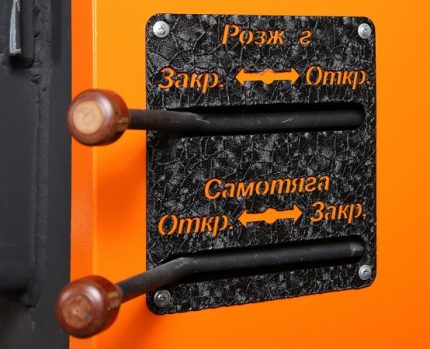
Too wet fuel in such devices is unacceptable. When it is burned, additional water vapor forms in the firebox, which contribute to the formation of by-products such as tar and soot.
The walls of the boiler become dirty, the heat transfer decreases, over time, the boiler may even stop working and die out.
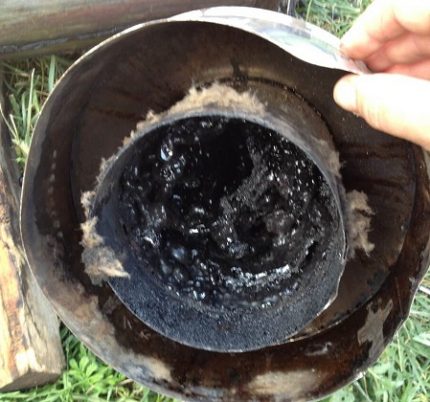
If dry fuel is put in the furnace and the boiler is set up correctly, the pyrolysis gas obtained as a result of the device operation will produce a yellow-white flame. Such combustion is accompanied by a negligible emission of by-products of fuel combustion.
If the flame color is painted differently, it makes sense to check the quality of the fuel, as well as the settings of the device.
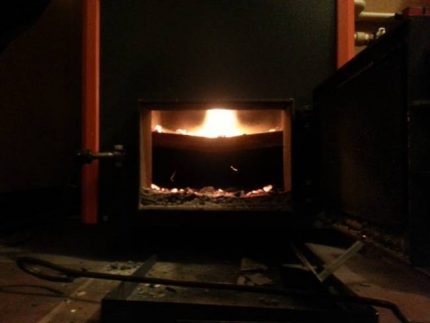
Unlike conventional solid fuel devices, before loading firewood into pyrolysis boilers running on solid fuel, the furnace should be heated.
To do this, perform the following steps:
- Small dry kindling (paper, wood chips, etc.) is loaded onto the bottom of the furnace
- Set fire to it with a torch from similar materials.
- Close the door of the combustion chamber.
- The loading chamber door is left slightly ajar.
- Add portions of kindling as it burns.
- The process is repeated until a smoldering coal layer is formed at the bottom.
At this point, the furnace is already warming up to about 500-800 ° C, creating conditions for loading the main fuel. Do not use gasoline, kerosene or any other similar liquid substances to light the kindling. Before warming up the furnace of a long-burning boiler, make sure that the device is ready for operation.
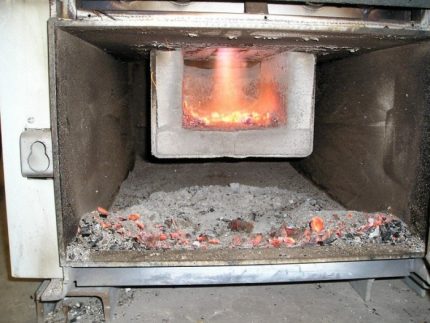
To do this, check for traction, the tightness of the doors, the serviceability of locking mechanisms and adjusting equipment, the presence of coolant in the heating system etc.
Then turn on the thermostat to make sure that the device is receiving voltage. After that, the direct draft gate is opened and the boiler is ventilated for 5-10 minutes.
Browse Popular Models
It should be understood that any pyrolysis boiler is a rather heavy unit, which is not intended for hanging on a wall. Such devices can be used both for heating a small house, and for spacious cottages. Like other heating units, long burning boilers vary in power.
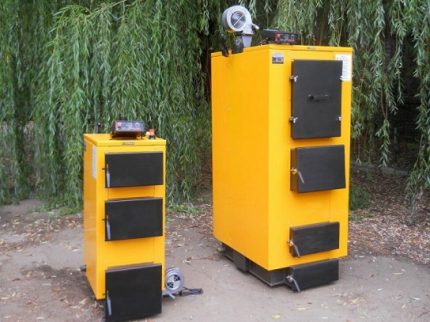
This indicator is usually oriented by buyers.
Among the popular models of this technique should be mentioned:
- Atmos (Ukraine) - represented by devices that can operate on wood and coal, power varies from 14 to 75 kilowatts.
- Attack (Slovakia) - able to cope with space heating up to 950 square meters. m, some models are able to continue working even in case of power outages.
- Bosch (Germany) - high-quality products of a well-known brand, power varies between 21-38 kilowatts.
- Buderus (Germany) represented by rulers Elektromet and Logano, the first is well known in Europe as a classic version of the pyrolysis boiler, the second is more modern versions designed for private homes.
- Gefest (Ukraine) - high-power devices with efficiency up to 95%.
- KT-2E (Russia) is specially designed for large residential premises, the unit capacity is 95 kilowatts.
- Opop (Czech Republic) - relatively inexpensive boilers, reliable and durable, power 25-45 kilowatts.
- Stropuva (produced in Lithuania or Ukraine) with a capacity of seven kilowatts is quite suitable for a small house, but more powerful devices are also presented in the model range.
- Viessmann (Germany) - an ideal choice for private households, the power starts from 12 kilowatts, the use of modern technologies allows you to save fuel.
- “Buran” (Ukraine) with a capacity of up to 40 kilowatts is another popular option for owners of large cottages.
- "Logics" (Poland) high-power devices of 20 kilowatts easily heat rooms up to 2 thousand square meters. m, it is rather a boiler for industrial needs: heating workshops, offices, greenhouses, etc.
When choosing a pyrolysis boiler for a private house, you should pay attention to models with two circuits in order not only to heat the dwelling, but also provide it with autonomous hot water supply.
The heat exchanger for domestic hot water can be storage or flow type. For the latter option, boiler models of increased thermal power are used.
If you want to save money, you can try to make a pyrolysis boiler with your own hands. The technology of its assembly is described in this article.
Conclusions and useful video on the topic
This video illustrates the principle of operation of the pyrolysis boiler:
A detailed overview of the operation of the upper combustion boiler can be found here:
Pyrolysis boilers are not cheap, but fully justify the funds invested in their purchase. With proper installation and maintenance, such devices will provide the house with stable and inexpensive heat.
Looking for a pyrolysis boiler for heating a house? Or have experience operating such units? Please leave comments on the article and share your impressions about the use of pyrolysis boilers. The feedback form is located in the lower block.

 Sensors for gas boilers: types, principle of operation, characteristics
Sensors for gas boilers: types, principle of operation, characteristics  How to choose a long-burning boiler: the best brands + tips for choosing heating equipment
How to choose a long-burning boiler: the best brands + tips for choosing heating equipment 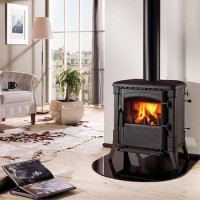 Combined boilers for heating a house: types, description of the principle of operation + selection tips
Combined boilers for heating a house: types, description of the principle of operation + selection tips  Solid fuel boilers: main types and criteria for choosing the best unit
Solid fuel boilers: main types and criteria for choosing the best unit 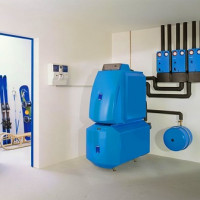 Liquid fuel heating boilers: device, types, overview of popular models
Liquid fuel heating boilers: device, types, overview of popular models  Automation for gas heating boilers: device, principle of operation, manufacturers overview
Automation for gas heating boilers: device, principle of operation, manufacturers overview  How much does it cost to connect gas to a private house: the price of organizing gas supply
How much does it cost to connect gas to a private house: the price of organizing gas supply  The best washing machines with dryer: model rating and customer tips
The best washing machines with dryer: model rating and customer tips  What is the color temperature of light and the nuances of choosing the temperature of the lamps to suit your needs
What is the color temperature of light and the nuances of choosing the temperature of the lamps to suit your needs  Replacement of a geyser in an apartment: replacement paperwork + basic norms and requirements
Replacement of a geyser in an apartment: replacement paperwork + basic norms and requirements
A pyrolysis boiler is good when there is no and is not expected to connect to the gas, or you live in a forest. In other cases, he is simply not justified, in my opinion. He is too capricious in operation and maintenance.
You need to constantly monitor the quality of firewood, they must be dry, of the same size, you must constantly monitor the condition of the chimney, otherwise the burner will clog it and the condensate will corrode. Although, my friends have had “Stropuva” for 10 years: at first there were difficulties, now I have not heard a single complaint from them about the boiler for a long time.